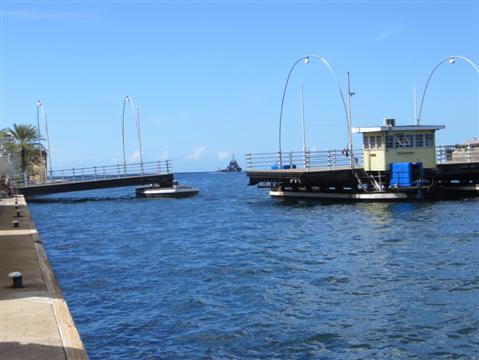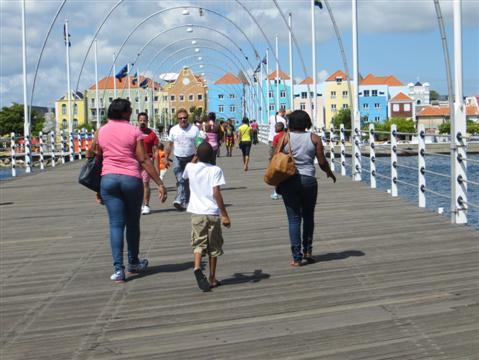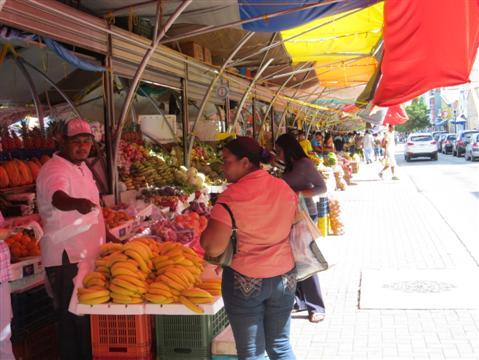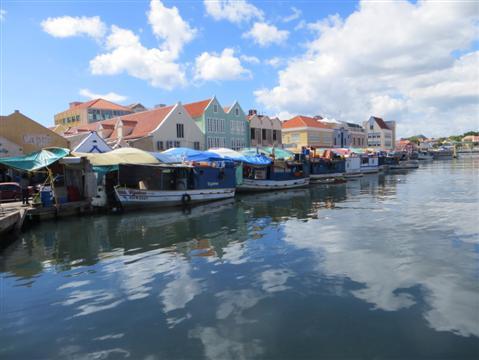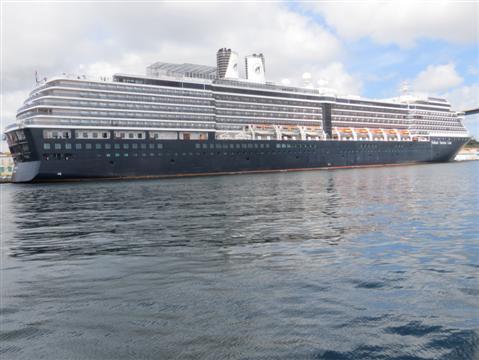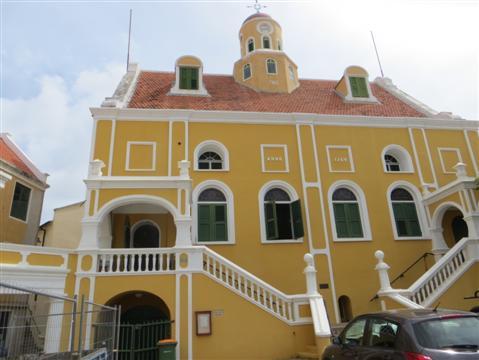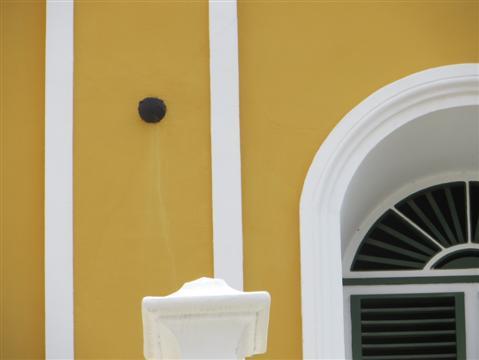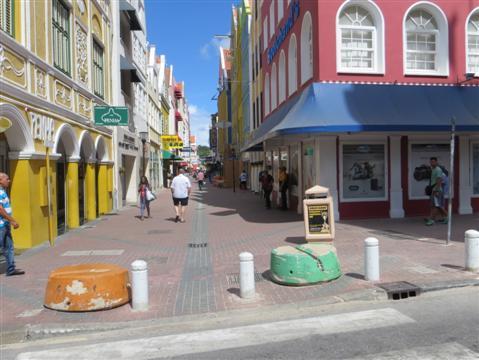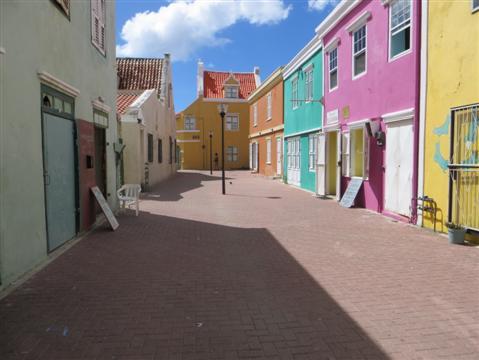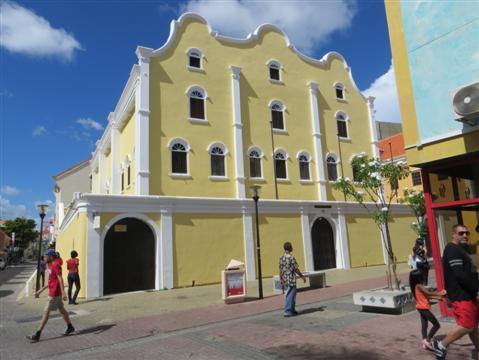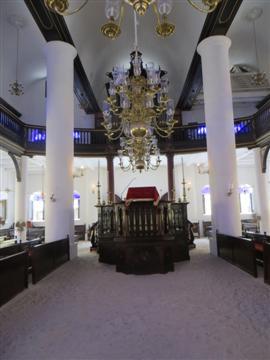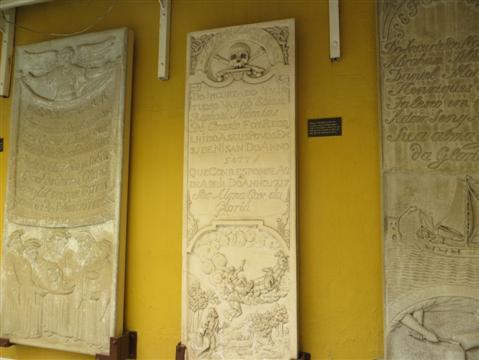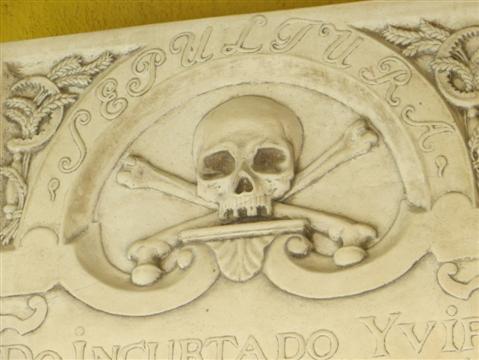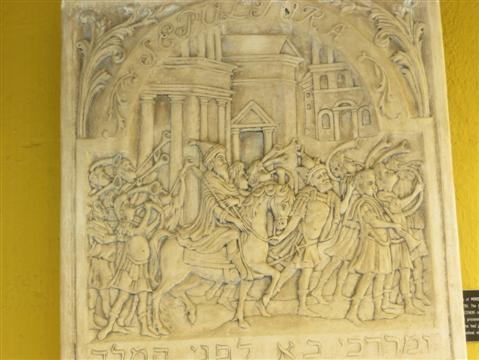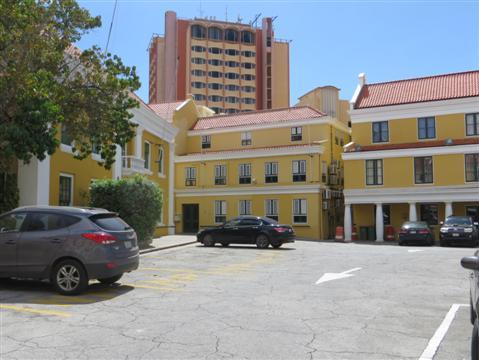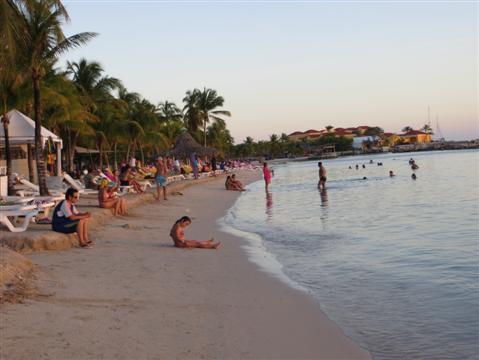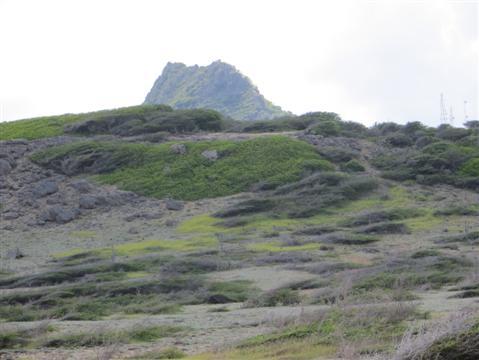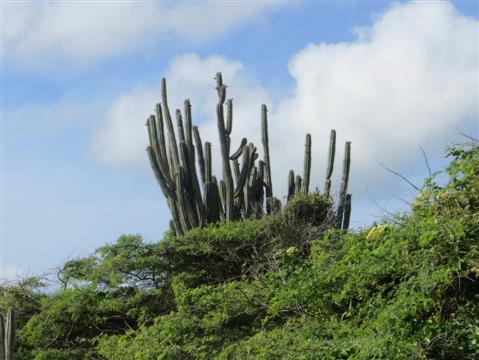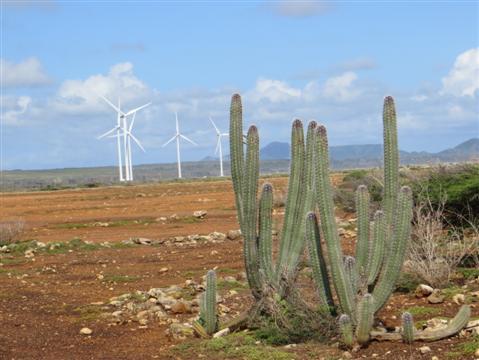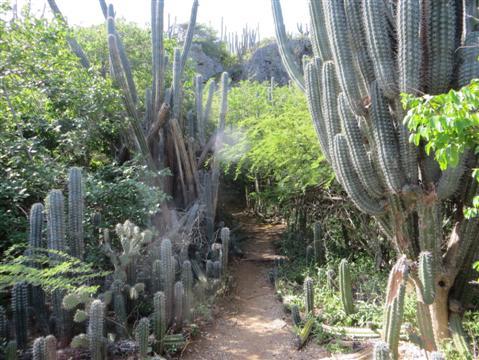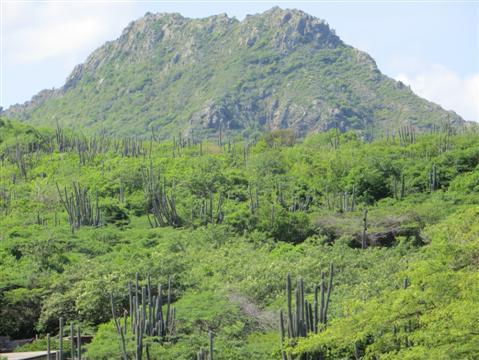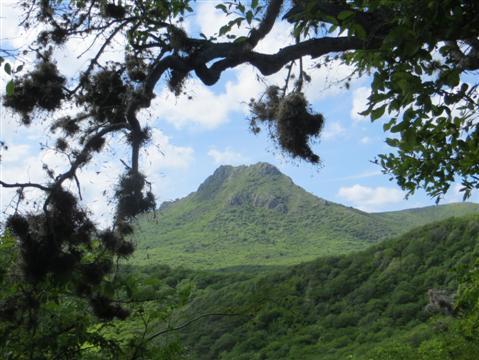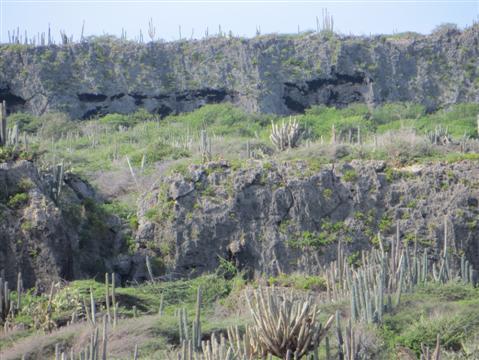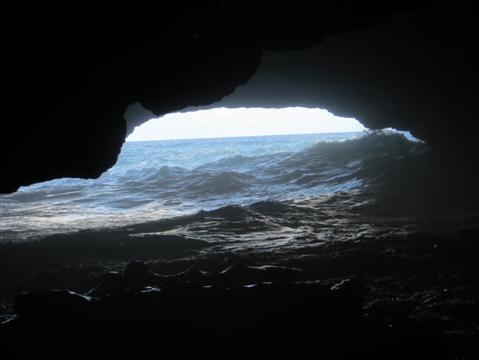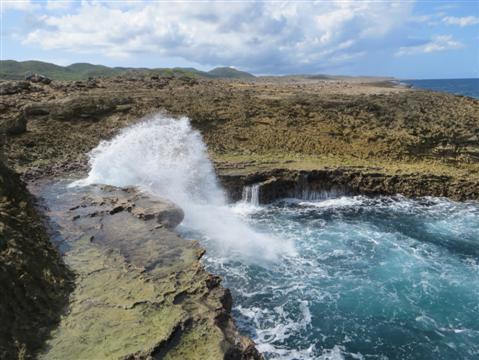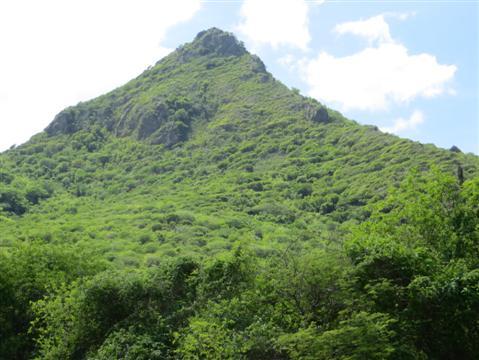Willemstad, Curaçao's capital, with its narrow four-storey traditional Dutch houses along an inlet from the Caribbean, looks just like a little Amsterdam, the buildings in a bold mix of red, blue, purple, pink, yellow and orange with sloping red tiled roofs, albeit on a 150-square-mile island in the tropics just 30 miles off the coast of Venezuela.
Willemstad waterfront, Punda side
The wooden pedestrian Queen Emma bridge, billed as the only floating pontoon bridge in the world, rings bells and swings wide open every time a ship wants to sail through from the harbour. It joins the oldest part of town, Punda, built in the early 1600s, with the government seat in Fort Amsterdam, to Otrobanda, once a suburb that grew up in the early 18th century. Not surprisingly both parts are a UN world heritage site.
Otrobanda, with Queen Emma bridge open
Pleasant outdoor cafes line the inlet, puffing cool air in steamy plumes from little pipes along the canvas coverings to temper the humid 84 Fahrenheit heat. Plenty of tourists amble by. Fortunately Baltimore Rachel the stalker doesn't heave into sight.
Almost closed
Open to pedestrians again
But I'm left wondering why they built a dirty great 14-storey tower in dirty fawn and pukey pink looking like a waterworks right on the old city's sea walls, totally overwhelming the charming old town within Fort Amsterdam's walls. The atrocity is the Plaza Hotel and Casino, but that doesn't excuse it.
Hotel and casino loom over historic Fort Amsterdam
I'm also left wondering why the floating market is called the floating market when it doesn't float. It's just a line of fruit and vegetable stalls along an inlet. But its merchants are Venezuelans who pop across the sea with their produce, mooring their boats behind their stalls. On the strength of that the market is called floating.
'Floating' market - front view
Back view
A dirty great cruise ship right in the inlet is blocking out 1,000 feet of shoreline along Otrobanda - the Holland America liner Zuiderdam with a capacity of 2,259 and a crew of nearly 1,000. I don't know if it's full but there are certainly large numbers of European and American antiques wandering around town. But then what am I?
Fort Church and its museum within Fort Amsterdam is the oldest church on the island, built in 1769 but it's undergone several restorations since, including replacing the original octagonal tower with a round one in 1903, and substituting a computerised gizmo for the clock's original clockwork in 1994.
Perhaps the most interesting item is a 20-pound English cannon ball lodged in its exterior wall where it has laid embedded since it was fired by the British in 1804 during the Napoleonic Wars.
Close-up
Of much greater interest is the Kura Holanda museum in Otrobanda with a magnificent display of objects detailing the various African origins of the slaves and the horrendous history of slavery. There are statues, masks, busts and heads with the histories of African empires such as Mali, Ghana, Sosso, Sossinke, and Songhay.
It stands on the site of a former slave yard and a slave merchant's mansion. There's a section on the former Dutch territory of Suriname, just across the Caribbean on the South American mainland, which alone absorbed 400,000 African slaves in about 200 years, with Curaçao serving as an auction market. If 400,000 arrived alive, how many hundreds of thousands perished in the crossings?
A Punda street
I learn something else, too, or else I'm forgetting what I once knew: Britain's Barclay's Bank was established in 1756 by David and Alexander Barclay on their profits from their slaving business, and Lloyds launched its greatness on its dabbling in and insuring slave ships and their cargoes.
An Otrobanda street
Punda holds the oldest synagogue in continual use in the Western hemisphere, Mikve Yisrael-Emanuel, dating from 1732. Wow, that's 37 years older than the Fort Church. Take that, vicar!
Portuguese Sephardi Jews first arrived in Willemstad from Brazil via Suriname in 1651. The synagogue itself is quite small with a nice wooden bimah (dais) and ark - and a floor of sand. There's a threefold reason for this.
Synagogue exterior
First it recalls the sands of Sinai where the tabernacle reposed while we were wandering around in the wilderness for 40 years some 3,500 years ago. Oh for a GPS back then!
Interior view with sand floor
Secondly it honours Jews forced to convert to Christianity but who secretly kept the faith and poured sand on the floors to muffle the sounds of worship. Thirdly it recalls God's order to Abraham to multiply like the grains of sand.
Another interior view
In the courtyard are copies of gravestones from the old Jewish cemetery. Unlike usual Jewish grave stones that merely have inscriptions these have friezes of biblical scenes, and often skull and crossbones. On one from 1717 a certain Elias Namias de Crasto has Elijah ascending to heaven in a chariot of fire at the bottom, with a skull and crossbones at the top.
The museum lady says this was done, despite one of the ten commandment to make no graven images, so as to meld in with general funerary art and hide the fact that the occupants were Jewish at the time of the inquisition.
Jewish tombstones
But Yours Truly posits that the skull and crossbones show that our coreligionaries were moonlighting as pirates and were honouring their new vocation. The lady does not take kindly to my theory.
Skull and crossbones close-up
Within the museum, staring out at me from a display cabinet, is a little case containing all the instruments that a mohel, the ritual Jewish circumciser, might need to practice his trade, craft or art, however you see it. The little case with its curved knives, scissors, clamps and a whole lot of other steel instruments I can't identify belonged to Moises Frois Ricardo, father of two generations of mohelim.
Right in front of the case are the rather fogged gold-rimmed spectacles that belonged to David Ricardo (1847-1941). Hmmm, that leaves plenty of room for an oops-me-darn-glasses-aren't-strong-enough moment. There's many a slip 'twixt the knife and the snip. OK, sue my optician, not me!
Jewish tombstone
Other items include a Torah scroll from 1320 smuggled out of inquisition-riven Spain before 1492, pictures of visits by the Dutch royal family, menorot, hagadot, and loads of photos and documents. There are now some 350 Jews in Curaçao compared with 2,000 in the 1700s.
Tombstone close-up
My hostelry is some way from the centre but there are gaming opportunities right opposite. Casino Royale full of alluring James Bond girls it ain't. The Princess Casino, one of dozens here, is full of fat old women squatting before praeternaturally complex fruit machines with zillions of flashing rows and columns and hundreds of buttons to press, their vast buttocks overflowing their perches.
Oh, bring back those one-armed bandits with just three rows and three columns of fruit. Still, Yours Truly decides to have a fling. I get a 'credit card' for 10 guilders, which gives me 1,000 credits, and hey presto, I'm pressing buttons galore here, pushing buttons galore there, and apart from one single row shot for one credit I'm multitasking those ruddy buttons so hard and fast that my credit's all shot in no time.
A Punda square overwhelmed by hotel
I give the credit card an extra hard push in its slot, and now it's freaking well got stuck inside, while I skedaddle outside.
Punda street
There's more to Curaçao, however, than just Willemstad. The island lacks the dramatic beauty and lush jungle greenery of many other Caribbean destinations with their conical mountains, but it is gently pleasing with plenty of palm-girt manicured beaches.
Beach near town
At the western end is stark-looking Mt. Christoffel, its highest point at 1,227 feet, while the eastern end just north of Willemstad is blessed with a dirty great oil refinery flaming away night and day. Scuba diving is a main tourist draw, which Yours Truly will avoid, not yearning for a watery Armageddon.
Mt. Christoffel from afar
The original inhabitants, peaceful Arawak, were soon put paid to by the frigging Spaniards and then Dutch who enslaved them, before turning the place into a major entrepôt for African slaves. The Dutch wanted the place for its salt, so that they could salt their freaking herrings.
The current inhabitants show a strong African heritage with traces of European and Amerindian. They are multilingual (Dutch, Spanish, English) but the local language is Papiamento, a mixture of Portuguese, Spanish, Dutch and some Arawak origins, which sounds a lot like Brazilian Portuguese. Good afternoon is bon tardi, while thank you is danki.
Island interior
Today, Curaçao is a constituent country of the kingdom of the Netherlands but is not in the euro zone like Holland and uses the Netherlands Antilles guilder.
Fortunately my tour round the island with Curaçao-Aktief, aktief being the Dutch for what you have already guessed, is not active at all in the sense of clambering up precipices or other such capers on which I can show off my total arseholeship.
Wind farm
The island is semi-arid. There are expanses of pebbly desert, barren with dull green shrubs and masses of cacti, but there are also large areas of heath with dry green vegetation, and plenty of green trees, if not exactly jungle lush, especially in Mr. Christoffel National Park.
Another view
Here there are magnificent views of the mountain's soaring peak, wild, craggy, multi-toothed, its ridge looking like the spikes on the back of some massive iguana.
The mountain
Another view
Of reel flesh and cold blood are the many large grey and black mottled iguanas ambling around in the dry forest, looking like fierce dragons even if they're placid. There are also some beautiful brilliant orange and black birds.
The island has several inland coral stone ridges and caves where the sea once reached a hundred thousand years ago, including the Kueba di Brua (witches' cave), where escaped slaves lived and cooked - and where semi voodoo-type rituals are still held.
Inland reefs
There's a sea cave, where the waves burst through from the open ocean, and a spewing blow hole. And there's the regulation tourist trap of getting yourself photographed with an iguana on your head. The guide gets the posers to pose with him with the iguana on his own head as he swings its enormous tail round in circles, then uses it to pick his nose.
Sea cave
On the plus side he's taught me the Papiamento for big arse, which he says are much in favour here abouts. It's hopi sanka. Now, why didn't I know that last night when I could have congratulated the ladies of the Princess Casino on their fine contributions to the national vogue?
Another mountain view
______________
By the same author: Bussing The Amazon: On The Road With The Accidental Journalist, available with free excerpts on Kindle and in print version on Amazon.
Swimming With Fidel: The Toils Of An Accidental Journalist, available on Kindle, with free excerpts here, and in print version on Amazon in the U.S here.



